Racial influences
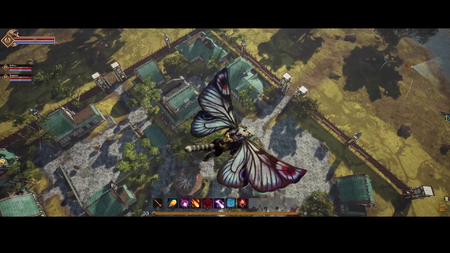
We have essentially sets that exist across all races; and each race that dons those armor sets is going to have their own racial influence on the presentation of those particular sets. So that's something that's unique in how each of the races get diversified. Additionally, the more that one particular race contributes to a node's development, it's going to manifest in that particular node's architectural influences. You're going to see the architectures of those races become manifest within the nodes as well: That's another way that we diversify each race and we present each race's culture in the game as through those architectures, through those props that exist, through the tailoring of the armor sets that the NPC might wear, to the different factions that exist. Factions will have their own affiliation with different races as well. Each race will also have some different nomenclature when it comes to the lore, or comes to locations in the world. They're going to have their own language influences as well: The way they speak is something that's going to be distinct between races; when you have dialogue trees with particular NPCs. So all of those things really go into setting an immersive world where the cultures have their own identity.[2] – Steven Sharif
Cultural influences manifest in many ways, from node and gear aesthetics to NPC languages and lore.[2][3][4]
- Gear appearance of certain armor sets is influenced by the player's race.[2]
- Node layout and style is influenced by the race that contributes the most to that node.[2]
- There is an attrition and that attrition on experience and influence is heightened based on the performance of the race in the world. So if all these nodes are Orc nodes then their attrition rate is very high to compete with the cultural establishment of new nodes because they have more influence in the world and a popular opinion is against them in their outlying regions that they do not have influence in.[5] – Steven Sharif
NPC racial interaction
- NPCs will react differently to different character races.[6]
- Languages will be distinct between NPC races and in the lore.[2]
- Certain quest givers and NPCs may only be present at nodes with certain cultural influences.[7]
- Depending on the cultural influence of the node activates certain types of quest lines and/or sponsors. Some of those are shared, some of those are general. Some of those relate to a progression path that is a first time user experience. Those will be constant across all culture types. Some of them, however, are predicates that spawn when certain story arcs and/or events, or commissions or buy orders become present within the node; and those might change based on the cultural influence of the node. So there is a separation between those populations.[7] – Steven Sharif
NPC languages
The race of a NPC influences its language and nomenclature in terms of its dialogue tree.[2]
Artistic influences
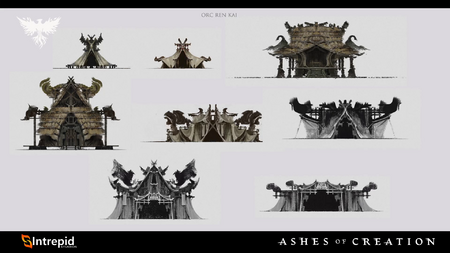
Character races are super important. These are the choices that we make at the onset of our adventure in an MMORPG: what race- not just mechanically aligns with our decisions, if those races have game mechanics behind them from a stat perspective, but visually and culturally and historically: What are these? What do these races represent? So it's important that visually they're distinct. And everyone's seen fantasy games do Elves, so everyone's seen them do Humans, everyone's seen them do Orcs: There's an established expectation almost behind what these traditional fantasy races represent; and there's a risk, because whenever you're creating a new IP or a new story or a new world- a new Universe; a realm in which things don't have to always be the norm, you can take a little bit of creative liberty to redefine some of the aspects of a particular race; and that can be a good thing, because it's something that is new to players. It's something that is unique to the realm that we're building- the surroundings that you have. So what we wanted to do was push a little bit more on the unique side of what the Py'rai would look like from a visual perspective.[9] – Steven Sharif
- Aelean architecture has a French medieval influence.[10]
- Dünir have a Nordic cultural influence.[11]
- Empyreans have a Greco-Roman imperialistic feeling.[12]
- The Kaelar have a European influence.[13]
- The Niküa have a Polynesian influence.[14][12]
- The Py'Rai have a Navajo Native American influence.[12] Py'Rai architecture has a woodland inspiration.[15][16]
- Pyrian architecture has a Greco-Roman influence.[17]
- Ren'Kai architecture has an Asian influence.[8]
- The Vaelune have a Middle Eastern influence.[18]
- The Vek have a Mesoamerican influence.[18]
- You will see in the different races that are available from a player character standpoint a lot of different influences that reflect many cultures in the world: Not just European, not just Africa, not Mesoamerican. These cultures are going to be present in many of the races.[19] – Steven Sharif
- The idea is just to find a base component in the real world as a starting point and then to begin to fantasize.[10] – Steven Sharif
Racial weapons and armor
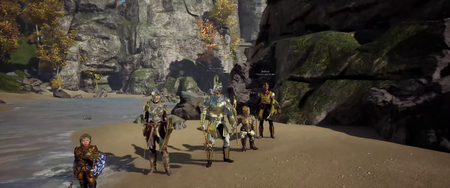
Violet light and myself are wearing exactly the same armor set right: Same stats, same everything, but it drops for her it looks one way, it drops for me it looks another way; and... a small part of that is gender, but then the other part of it is race. So because I was a Vaelune in that playthrough my armor was in the Vaelune style; and when she picked it up it was in the elven style because she was an elf. So that gives you an example of sort of the breadth of looks that we're going for and how we try to capture like who you are as as a character and allow you to build your look that way.[21] – Jeffrey Bard
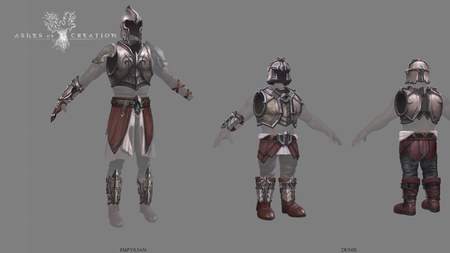
We have essentially sets that exist across all races; and each race that dons those armor sets is going to have their own racial influence on the presentation of those particular sets. So that's something that's unique in how each of the races get diversified.[2] – Steven Sharif
Armas and armor are not race locked, but armor will take on a racial appearance.[2][23][24]
- The customization of equipment per race is really focused on Armor sets not Weapon props. Weapon props will, from a model standpoint, will translate pretty one-to-one across the races.[25] – Steven Sharif
- Racial appearance of gear is focused on Armadura. Armas will not change in appearance but will scale in size based on race.[26][25]
- Let's say for example you have the Eagle set or something, right: The Eagle set has in art, it has a thematic design that's going to include certain attachments to the armor. It's going to include color palette and theme. It's going to have some aspects to it that define it as the Eagle set, right. When a Elf wears the Eagle set or when an Orc wears the Eagle set, you obviously have two different cultures there; and you don't want to stomp out that culture by assigning a de facto 'This is the Eagle set and this is how it looks on everybody.' What we want to have is cultural influences play a role in showing how that set looks.[25] – Steven Sharif
- Racial appearance of gear sets is tied to the character model of that race.[27]
- When you say, what if I'm an Orc but want to look like an Elf and I want my Eagle set to be the Elf representation? Well the issue becomes there that Orcs have a different organic model. You know, their body is different than that of the Elf. So, from a scope-creep standpoint, it's one thing to add different influences that represent the cultures that are donning the armor; it's another thing to adapt each influence as a matrix that can be worn pretty much by everything. From a scope perspective, that's a very difficult task for the character artists to tackle. So instead what we've done is, in order to facilitate a variety of cultural representation between the races but allow for the sharing of assets like different armor sets, we give different representations of those armor sets to each race.[27] – Steven Sharif
- Q: Since a single armor set will look different on each race, how will we have large varieties of in-game achievable gear for each race if we have to make nine different looks for each set?
- A: The approach for that is to create a modular piece set for armor creation; and the way we achieve that is by two steps: So, on the modeling side, each race has these geo sets basically where you're creating pieces of the armor for heavy plate armor, for medium, for robes; and you get to grab those modular pieces and mix and match as design makes a request for a particular set to the art teams. So, design comes along and they say, "hey we have a theme for a set that we want to create", so let's use Carphin in that example; and that theme from design's standpoint is going to include color, it's going to include materials, it's going to have an etymology for the set to give a background so that they can incorporate certain types of attachments- whatever they want to include on the art side. Then, the character team says, "okay let's take our base sets of geo and let's mix and match those pieces to create the Carphin set and then we're going to do a materials pass on it, and then we're going to do a color pass on it"; and that way we have a lot of essentially pieces of the puzzle to create these many different unique sets. Now we can also deform pieces across from race to race. So, even if we create unique geo on a per-race basis, we can grab the pauldron from the Human set and put it onto the Vek representation; and the end game there is that we have a particular set, for example Carphin, and that Carphin is communicating the theme; and when you don the armor for the Carphin set- you've acquired the Carphin set and you put it on- it is going to look Vek if you're a Vek. It is going to look Kaelar if you're a Kaelar, but it is still going to have the identity and the theme of the Carphin set.[28] – Steven Sharif
Node layout and style

Já no terceiro estágio de evolução, como uma vila, é um layout razoavelmente grande; e parte desses layouts inclui domicílos essencialmente estáticos, dentro da base, que os jogadores podem comprar.[1] – Steven Sharif
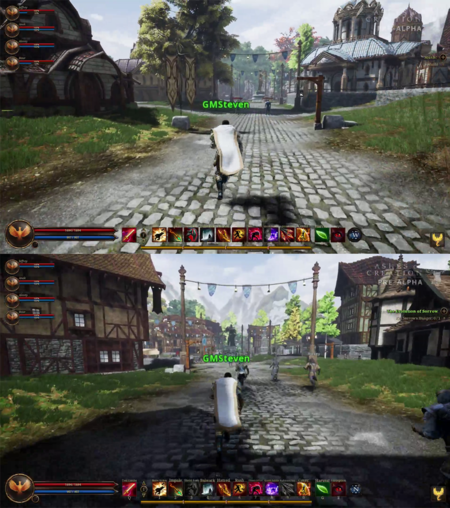
O layout e a arquitetura dentro da área de desenvolvimento de uma Base são determinados pela raça com mais influência. Por exemplo, uma Base em estágio 3 onde a maioria dos jogadores contribuíntes é Py'Rai terá uma vila Py'Rai com arquitetura Py'Rai. A maioria dos PNJs seriam elfos Py'Rai, e ofereceriam missões com narrativa Py'Rai.[30] – Margaret Krohn
A experiência contribuída por cada jogador é marcada com sua raça e outros identificadores. Quando uma Base evolui, a raça com a maior contribuição de experiência determina o estilo e cultura da Base. Essa mudança de estilo e cultura pode ocorrer em todo Estágio de Base. Por exemplo, se uma Base avança para o Estágio 2 - Acampamento e 51% de toda a experiência veio de jogadores Ren'Kai, a Base será uma Base Ren'Kai Estágio 2. Se essa mesma Base avançar para o Estágio 3 - Vilarejo, mas dessa vez os Py'rai tiverem contribuído 62% de tpda a experiência obtida, a Base se tornará uma Base Py'Rai Estágio 3. Influências culturais trazem mudanças além da estética e das missões - benefícios são dados àqueles da cultura dominante dentro da Zona de Influência daquela Base.[4] – Margaret Krohn
O layout e o estilo de uma Base são determinados por diversos fatores:[31]
- Localização da base.[31]
- Tipo de Base.[31]
- Raça que mais contribuiu para a evolução da Base.[31][32]
- Aparências raciais dos prédios e dos PNJs de uma Base.[33][32]
- Isso se aplica a todas as bases, incluindo bases de castelo.[34]
- O resto é determinado pelo prefeito da base.[31]
Algumas partes são determinadas pela área onde a base está. Outras, pelo tipo da base; certas partes são determinadas pela raça, e o resto é determinado pelo prefeito.[31] – Jeffrey Bard
Todas as bases, sejam elas relacionadas aos castelos ou não, têm influências culturais que são replicadas nas aparências dos prédios e dos PNJs presentes na Base.[34] – Steven Sharif
Existe uma mecânica de atrito que afeta a experiência e influência para impedir que uma única raça domine o mundo inteiro.[5]
Existe um atrito e esse atrito na experiência e influência aumenta de acordo com a performance da raça no mundo. Então se todas as bases forem de Orc, o nível de atrito deles será muito alto para competir com outras raças na hora de estabelecer a cultura de novas bases. Isso acontece pois já são muito influentes e existe uma opinião popular contra eles nas regiões que não influenciam.[5] – Steven Sharif
Missões Raciais
Missões poderão ser baseadas na raça de um personagem.[6]
Missões diferentes poderão ser relacionadas ao principal contribuidor cultural em uma base. Isso não travará nenhum conteúdo, mas dará um toque único às missões.[6]
Poderão haver até grupos diferentes de missões que existem para raças específicas, e mesmo que vocês estejam dividindo uma missão para matar um chefe, se você é um humano e eu, um elfo, eu terei uma jornada diferentes que potencialmente me levará em uma direção diferente da sua, mesmo que nossa missão inicial seja a mesma; e isso poderá ser relacionado à principal cultura que contribuiu em uma base, liberando diferentes jornadas para culturas que dividem a mesma dessa principal - não com o objetivo de travar conteúdos, mas sim de dar um toque especial para que não seja tudo igual.[6] – Steven Sharif
A raça importa pois as narrativas têm caminhos que também sãoa influenciados de acordo com a principal cultura deuma base... Se você é um Niküa e está em uma base Niküa que é predominantemente Niküa, terá certos serviços ou habilidades como membro dessa raça que outras raças não poderão acessar... Talvez eles tenham missões narrativas alternativas, mas não terão missões específicas. Assim, essas missões específicas dos Niküa vão se relacionar a uma meta-narrativa que está presente no mundo, e os jogadores teerão um certo controle sobre essa meta-narrativa; e isso será beneficial ao seu povo pois erá liberar certos conteúdos que outras raças ainda não liberaram. Então existe um incentive para progredir de maneira a impedir o progresso da raça dominante.[5] – Steven Sharif
Missões que são específicas de raça, título, ou clã serão menos de 10% do total de missões. 90% das missões serão iguais para todos os jogadores.[35]
Ver também
Referências
- ↑ 1.0 1.1 1.2 Transmissão ao vivo, 2020-06-26 (45:32).
- ↑ 2.0 2.1 2.2 2.3 2.4 2.5 2.6 2.7 Transmissão ao vivo, 2022-03-31 (4:57).
- ↑ 3.0 3.1 Entrevista, 2021-02-07 (33:00).
- ↑ 4.0 4.1 Blog - Know Your Nodes - Advance and Destroy.
- ↑ 5.0 5.1 5.2 5.3 5.4 Entrevista, 2018-05-11 (1:00:19).
- ↑ 6.0 6.1 6.2 6.3 6.4 Podcast, 2018-04-23 (29:56).
- ↑ 7.0 7.1 Entrevista, 2023-07-09 (1:35:28).
- ↑ 8.0 8.1 Transmissão ao vivo, 2019-10-31 (40:27).
- ↑ Transmissão ao vivo, 2022-02-25 (49:42).
- ↑ 10.0 10.1 Entrevista, 2018-10-20 (3:47:17).
- ↑

- ↑ 12.0 12.1 12.2 Entrevista, 2018-05-11 (1:03:21).
- ↑ Podcast, 2018-05-11 (31:35).
- ↑ Transmissão ao vivo, 2022-09-30 (1:08:24).
- ↑ Transmissão ao vivo, 2022-02-25 (44:28).
- ↑

- ↑ Transmissão ao vivo, 2017-10-16 (15:58).
- ↑ 18.0 18.1 Podcast, 2018-05-11 (31:35).
- ↑ Entrevista, 2018-05-11 (1:04:27).
- ↑ Vídeo, 2020-09-30 (2:44).
- ↑ Transmissão ao vivo, 2020-09-30 (47:47).
- ↑ Transmissão ao vivo, 2019-07-26 (54:06).
- ↑ Transmissão ao vivo, 2017-05-26 (44:11).
- ↑ Transmissão ao vivo, 2017-05-26 (20:46).
- ↑ 25.0 25.1 25.2 Podcast, 2018-08-04 (53:43).
- ↑ Transmissão ao vivo, 2022-10-28 (1:41:06).
- ↑ 27.0 27.1 Podcast, 2018-08-04 (55:17).
- ↑ Transmissão ao vivo, 2024-02-29 (1:15:51).
- ↑ Transmissão ao vivo, 2018-02-09 (33:50).
- ↑ Blog - Know Your Nodes - The Basics.
- ↑ 31.0 31.1 31.2 31.3 31.4 31.5 Transmissão ao vivo, 2018-09-27 (53:06).
- ↑ 32.0 32.1 Entrevista, 2018-05-11 (54:34).
- ↑ Transmissão ao vivo, 2017-05-26 (21:23).
- ↑ 34.0 34.1 Entrevista, 2018-05-11 (47:27).
- ↑ Transmissão ao vivo, 2019-07-26 (1:13:23).